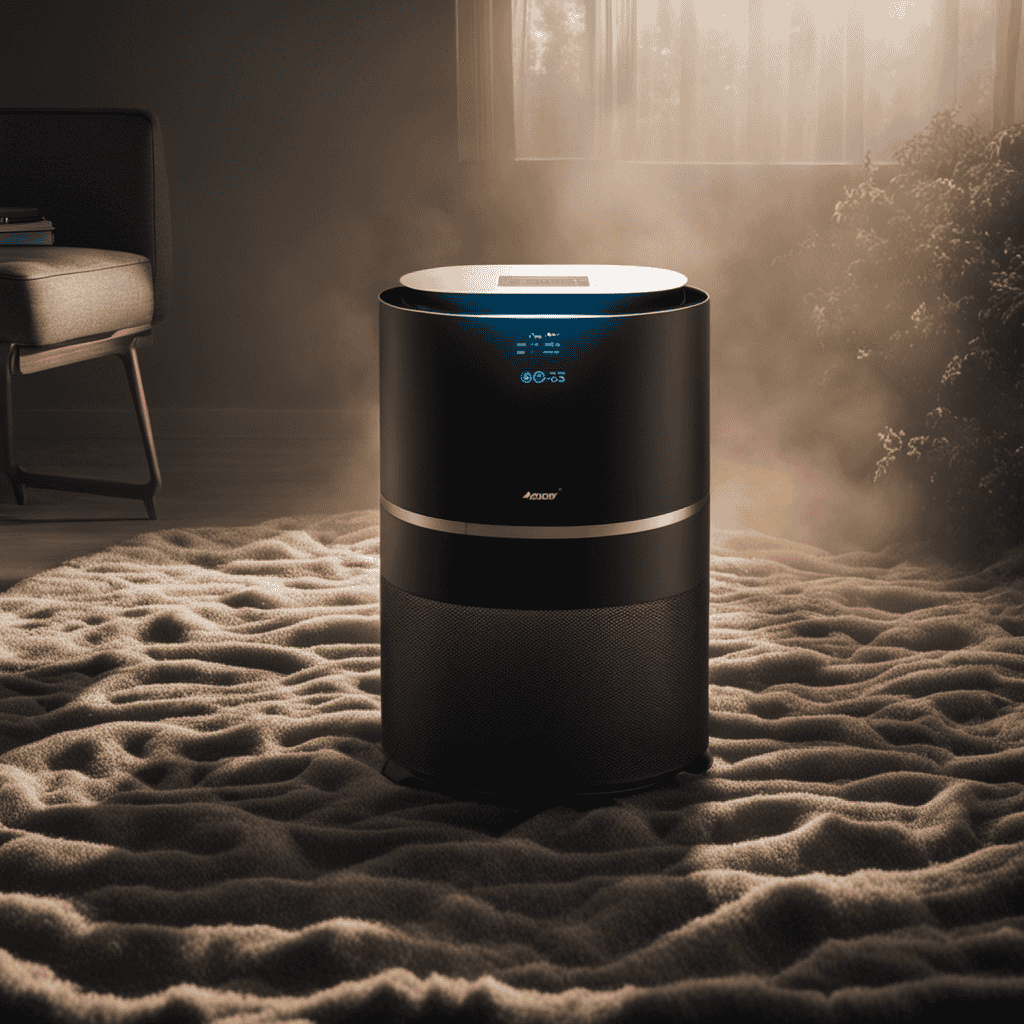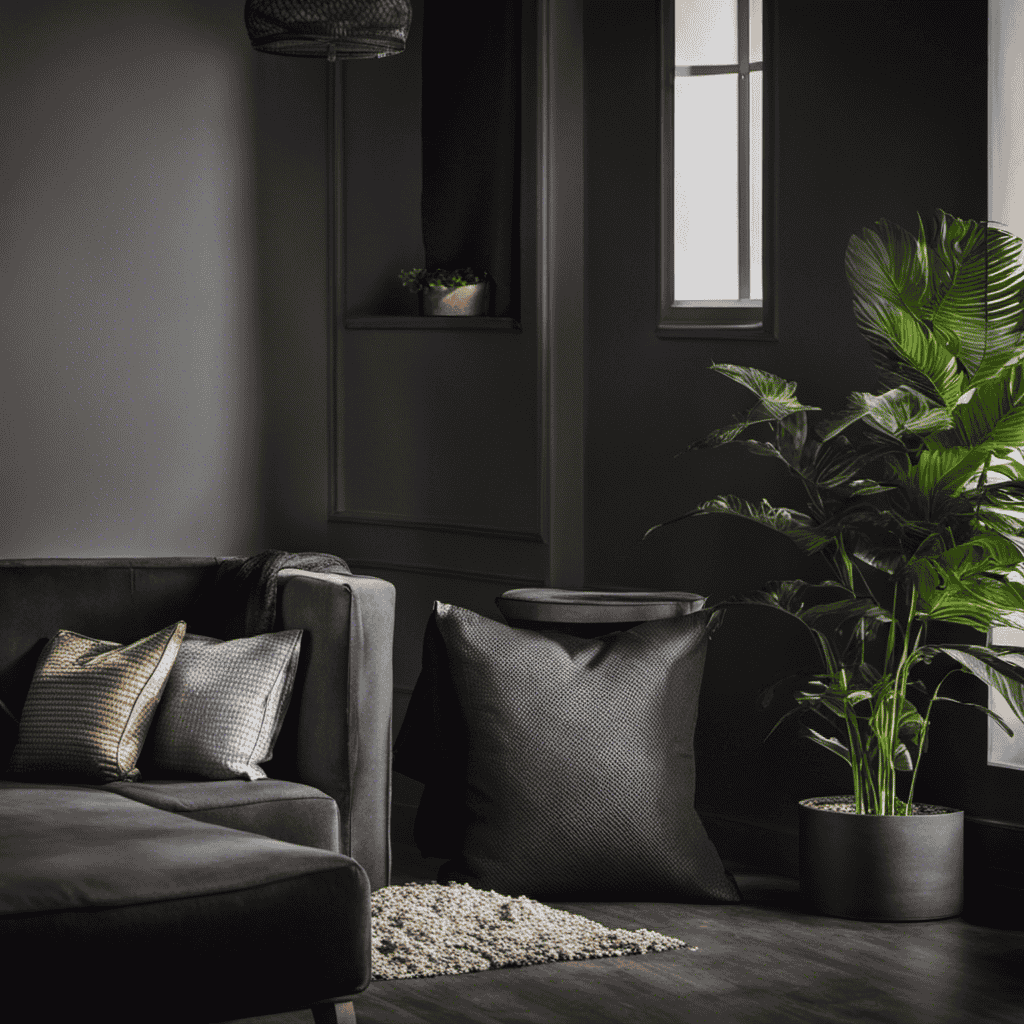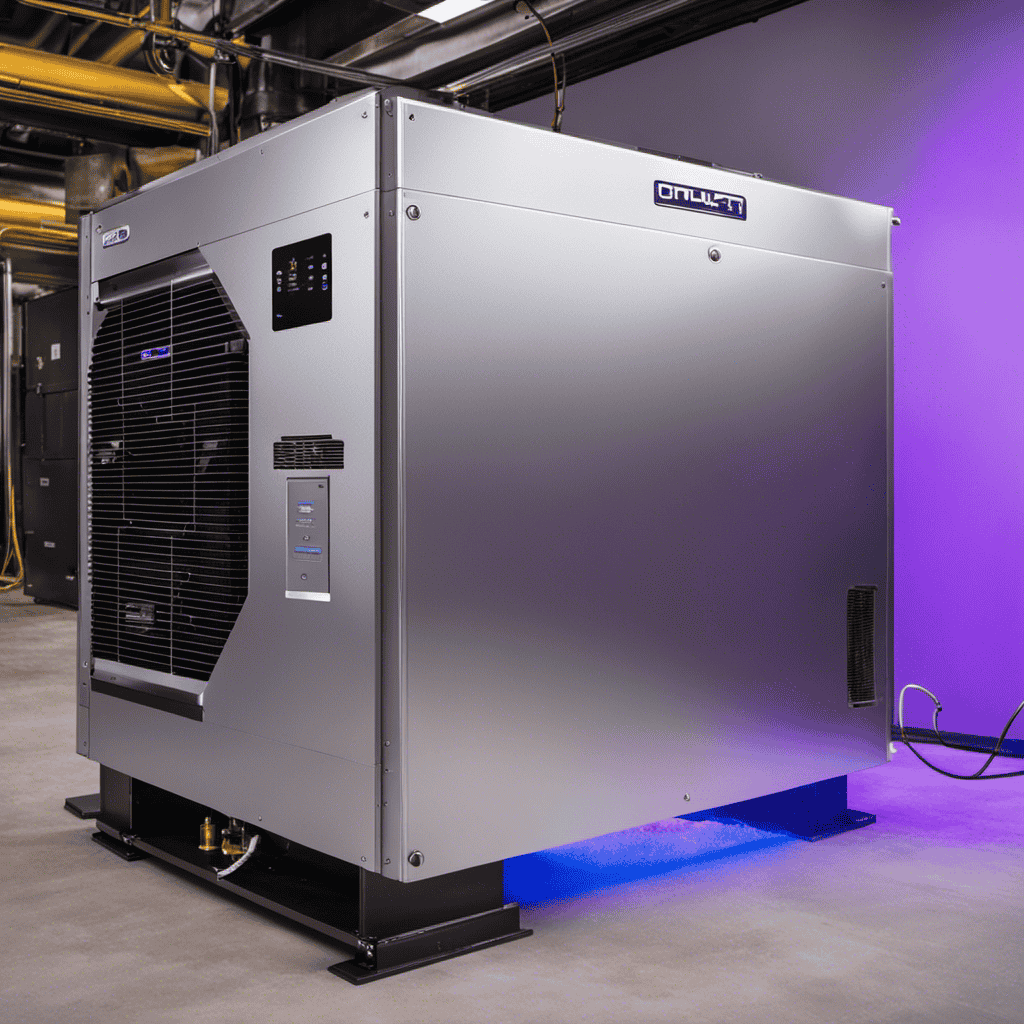I have always been curious about how much electricity air purifiers consume as a dedicated user of these machines.
In this article, I will delve into the technical aspects and data-driven analysis of air purifiers’ energy usage. By comparing different models and exploring energy-efficient features, we will uncover the true cost of running an air purifier.
So, if you’re looking to make an informed decision about your air purification needs, stay tuned for some intriguing insights.
Key Takeaways
- Wattage indicates the amount of electricity consumed by an air purifier.
- Energy efficiency rating determines how efficiently the device uses power.
- Factors such as room size, filter type, and fan speed settings can affect the energy usage of air purifiers.
- Energy-efficient models with advanced filtration systems, real-time air quality sensors, and programmable timers are available to reduce power consumption.
Understanding Power Consumption of Air Purifiers
To understand how much power your air purifier uses, you’ll need to consider the wattage and energy efficiency rating.
The wattage indicates the amount of electricity consumed by the device, while the energy efficiency rating tells you how efficiently it uses that power. These factors play a crucial role in determining the overall performance of the air purifier and its impact on indoor air quality.
The wattage of an air purifier can vary depending on its size, specifications, and features. Generally, larger air purifiers tend to have higher wattage as they need more power to effectively clean larger spaces. Additionally, air purifiers with advanced filtration systems or additional features like air quality sensors may also consume more power.
The energy efficiency rating of an air purifier is equally important. A higher energy efficiency rating means that the device uses less electricity to perform its functions, resulting in lower energy consumption and cost. It also indicates that the air purifier is designed to minimize energy wastage and operate more efficiently.
Understanding the power consumption of your air purifier is crucial as it directly affects its performance and the quality of air in your indoor environment. By choosing an air purifier with the right wattage and energy efficiency rating, you can ensure optimal performance while minimizing energy usage and its associated costs.
Now, let’s delve into the factors that affect energy usage in air purifiers.
Factors Affecting Energy Usage in Air Purifiers
One of the factors that affect the energy usage in air purifiers is the size of the room it is being used in. The larger the room, the more energy the air purifier will require to effectively clean the air.
Here are four key factors that can impact the energy usage of air purifiers:
-
Room size: As mentioned, the size of the room plays a significant role in determining the energy consumption of an air purifier. A larger room will require a more powerful air purifier, resulting in higher energy usage.
-
Filter type: Different air purifiers utilize different types of filters, such as HEPA filters or activated carbon filters. The type and quality of the filter can impact the energy usage, as some filters may require more energy to operate efficiently.
-
Fan speed: Most air purifiers offer multiple fan speed settings. Running the air purifier at a higher fan speed will result in increased energy consumption. However, it is important to find a balance between energy usage and the desired level of air purification.
-
Maintenance: Proper air purifier maintenance, including regular filter cleaning or replacement, can help optimize its energy efficiency. Clogged filters can restrict airflow and make the device work harder, consuming more energy.
Considering these factors can help in optimizing the energy usage of air purifiers while ensuring effective air purification. Now, let’s delve into comparing the power consumption of different air purifier models.
Comparing Power Consumption of Different Air Purifier Models
When it comes to air purifiers, power usage variations can play a significant role in determining their overall energy efficiency. Different models can vary in terms of the power they consume, with some being more energy-efficient than others.
This can have an impact not only on the environment but also on the cost of operation for the user.
Power Usage Variations
Understanding the power usage variations of air purifiers can help you make an informed decision about which one to choose. Here are four key factors to consider when it comes to the energy efficiency of air purifiers:
-
Power Consumption: Air purifiers have different power consumption levels, typically ranging from 10 to 100 watts. Opt for models that have lower power consumption to save on energy costs.
-
Fan Speed Settings: Air purifiers with multiple fan speed settings allow you to adjust the power usage according to your needs. Running the fan on lower settings can help save energy.
-
Timer Function: Look for air purifiers with a timer function that lets you schedule when the device turns on and off. This allows you to optimize power usage and only have the unit running when needed.
-
Energy Star Certification: Consider air purifiers that are Energy Star certified. These models meet strict energy efficiency guidelines and can help reduce power consumption.
By understanding these energy efficiency factors, you can choose an air purifier that not only improves indoor air quality but also saves energy and reduces your ecological footprint.
Now, let’s explore the next section on energy-efficient models.
Energy-Efficient Models
Let’s take a look at the energy-efficient models available in the market.
When it comes to air purifiers, there are several energy-saving techniques that manufacturers are implementing to create green air purifiers. These models are designed to consume less power while still providing effective air purification.
One popular technique is the use of advanced filtration systems that require lower fan speeds, resulting in reduced energy consumption. Another energy-saving feature is the use of sensors that detect the air quality in real-time, adjusting the purification settings accordingly.
Additionally, some models come with programmable timers, allowing users to schedule the purifier’s operation during specific hours, saving energy when not needed.
With the increasing demand for energy efficiency, manufacturers are continuously developing innovative models that provide powerful air purification while minimizing power consumption.
Cost of Operation
In my previous discussion on energy-efficient air purifiers, I highlighted the importance of choosing models that consume less power. Now, let’s delve into the cost of operating these devices.
Conducting a long-term cost analysis is crucial when considering an air purifier’s overall affordability. Here are four key cost-saving measures to consider:
-
Energy consumption: Opt for air purifiers with Energy Star certification, as they are designed to consume less electricity.
-
Filter replacements: Regularly replacing filters ensures optimal performance and energy efficiency, reducing long-term costs.
-
Timer function: Utilize the timer feature to schedule operation during specific hours, avoiding unnecessary electricity usage.
-
Maintenance: Properly maintaining your air purifier, such as cleaning the filters regularly, can extend its lifespan and reduce the need for costly repairs or replacements.
Tips for Reducing Energy Consumption of Air Purifiers
One way to reduce the energy consumption of air purifiers is by adjusting the fan speed. By lowering the fan speed, the air purifier can still effectively clean the air while using less power. This is because the fan is one of the main components that consume energy in an air purifier. By reducing the speed, the fan consumes less electricity, resulting in lower energy consumption.
In addition to reducing energy consumption, adjusting the fan speed can also help in reducing noise pollution. Air purifiers with high fan speeds can be quite noisy, especially in smaller spaces. By lowering the fan speed, the noise level is reduced, creating a more peaceful and comfortable environment.
To further optimize the energy efficiency of an air purifier, regular maintenance is essential. Cleaning or replacing the filters regularly ensures that the air purifier operates at its maximum efficiency. Clogged filters can cause the fan to work harder, consuming more energy.
Energy-Efficient Features to Look for in an Air Purifier
When considering an air purifier, it’s important to assess its power-saving capabilities, energy consumption comparison, and efficient filtration technology.
Power-saving capabilities refer to the features that allow the air purifier to operate efficiently and minimize energy usage.
Energy consumption comparison involves evaluating the energy consumption of different air purifiers to determine which ones are more energy-efficient.
Lastly, efficient filtration technology refers to the advanced filtration systems that effectively remove pollutants from the air while consuming less energy.
Power-Saving Capabilities
You can easily save power with an air purifier that has built-in power-saving capabilities. Here are some power saving tips to consider when choosing an air purifier:
-
Energy Saving Modes: Look for models that offer different energy saving modes, such as a sleep mode or an eco mode. These modes automatically adjust the fan speed and power consumption based on the air quality in the room, helping to conserve energy when purification is not required at full capacity.
-
Timer Function: Opt for air purifiers that come with a timer function. This allows you to set a specific operating time, so the device will automatically turn off after a predetermined period. This feature helps to prevent unnecessary power consumption when you’re not using the air purifier.
-
Smart Sensors: Consider air purifiers with smart sensors that can detect the air quality in the room. These sensors can adjust the fan speed and power consumption accordingly, optimizing energy usage based on the level of pollutants present.
-
Energy Star Certification: Look for air purifiers that are Energy Star certified. These models meet strict energy efficiency guidelines set by the Environmental Protection Agency (EPA), ensuring that they consume less power while still providing effective air purification.
By utilizing these power-saving capabilities, you can reduce the energy consumption of your air purifier without compromising on its performance.
Now let’s explore the energy consumption comparison between different types of air purifiers.
Energy Consumption Comparison
Consider comparing the energy consumption of various air purifier models to find one that suits your needs and is energy-efficient.
When it comes to energy-saving tips, it’s important to consider the environmental impact of the appliances we use. Air purifiers can consume a significant amount of electricity, so choosing one with low energy consumption can make a difference.
Look for models with energy-saving features such as adjustable fan speeds or automatic shut-off timers. Additionally, pay attention to the energy efficiency rating of the air purifier, indicated by the Energy Star label. This label ensures that the unit meets strict energy efficiency guidelines set by the Environmental Protection Agency.
By selecting an energy-efficient air purifier, you can reduce your carbon footprint and save on electricity costs.
Now, let’s explore the efficient filtration technology used in these appliances.
Efficient Filtration Technology
To ensure clean and healthy air, it’s essential to choose an air purifier with efficient filtration technology. Filtration technology advancements have had a significant impact on air quality by effectively removing pollutants and allergens from the air we breathe.
Here are four key advancements in filtration technology that have improved air purifiers:
-
HEPA Filters: High-Efficiency Particulate Air (HEPA) filters are capable of capturing particles as small as 0.3 microns, removing a wide range of pollutants including dust, pollen, pet dander, and mold spores.
-
Activated Carbon Filters: These filters are designed to adsorb chemicals, odors, and gases, effectively reducing unpleasant smells and harmful volatile organic compounds (VOCs) from the air.
-
UV-C Light Technology: Ultraviolet Germicidal Irradiation (UVGI) technology uses UV-C light to sterilize and kill bacteria, viruses, and other microorganisms, ensuring cleaner and healthier air.
-
Ionizers: Ionizers release negatively charged ions into the air, causing particles to become positively charged and stick to surfaces, effectively removing them from the air we breathe.
Estimating the Cost of Running an Air Purifier
Estimating the cost of running an air purifier can be helpful in determining its long-term value. When considering the maintenance costs, it is essential to take into account the replacement filters and any additional components that may require regular servicing. These costs vary depending on the model and brand of the air purifier. On average, annual filter replacements can cost between $20 and $100. It is important to note that some air purifiers have reusable filters, which can help reduce maintenance costs in the long run.
Another significant aspect to consider when estimating the cost of running an air purifier is its impact on the electricity bill. Air purifiers typically consume between 50 and 200 watts of electricity, depending on the size and features of the unit. To determine the exact impact on your electricity bill, you can use the formula: (Wattage / 1000) x Hours of Daily Use x Cost per Kilowatt-hour. This will give you an estimate of the daily, monthly, and annual electricity consumption cost.
Can I Use an Air Purifier Without Consuming Too Much Power?
Yes, you can use an air purifier without worrying about the power consumption of air purifiers. Many energy-efficient models are available that consume very little power. Look for an Energy Star certified air purifier and follow the manufacturer’s recommendations for optimal energy use.
Frequently Asked Questions
Can an Air Purifier Be Left on 24/7 or Should It Be Turned off When Not in Use?
Leaving an air purifier on 24/7 can affect its lifespan and energy consumption. Continuous operation may lead to wear and tear, reducing the device’s efficiency over time.
Additionally, keeping it running when not needed unnecessarily consumes power. It’s important to strike a balance between air purification and energy conservation.
Regularly monitor indoor air quality and turn off the purifier when it’s not necessary to maintain optimal performance and conserve energy.
How Long Does It Typically Take for an Air Purifier to Clean the Air in a Room?
How effective are air purifiers in removing viruses and bacteria?
The effectiveness of air purifiers in removing viruses and bacteria depends on the type of purifier you choose. There are different types of air purifiers available in the market, such as HEPA filters, UV germicidal lamps, and activated carbon filters.
Each type has its own strengths and limitations when it comes to eliminating airborne pathogens. It is important to research and select the right purifier based on your specific needs and concerns.
Are There Any Health Risks or Side Effects Associated With Using an Air Purifier for Extended Periods of Time?
Using an air purifier for extended periods of time can have potential health risks. It is important to consider long-term effects and air purifier safety.
Continuous exposure to purified air may lead to dryness and irritation of the respiratory system. Additionally, some air purifiers generate ozone, which can be harmful in high concentrations.
It is crucial to choose an air purifier that meets safety standards and to use it in a well-ventilated space to minimize any potential risks.
Can Air Purifiers Be Used in Conjunction With Other Appliances or Devices, Such as a Heater or Air Conditioner?
Air purifiers can be used in conjunction with other appliances or devices such as a heater or air conditioner. This combination allows for improved air quality while maintaining a comfortable temperature.
However, it is important to consider the heating effectiveness and energy consumption of the appliances when used together. By properly managing the settings and ensuring efficient operation, the air purifier can effectively clean the air without significantly impacting the overall energy usage.
Are There Any Specific Maintenance Tasks That Need to Be Performed Regularly to Ensure the Optimal Performance and Energy Efficiency of an Air Purifier?
Regular maintenance tasks are crucial to ensure optimal performance and energy efficiency of an air purifier. These tasks include cleaning or replacing the filters, removing any accumulated dust or debris, and checking for any malfunctions or worn-out parts.
By performing these maintenance tasks regularly, you can ensure that your air purifier is operating at its best, effectively removing pollutants from the air and minimizing energy consumption.
It’s like giving your air purifier a tune-up to keep it running smoothly and efficiently.
Conclusion
In conclusion, after analyzing the power consumption of air purifiers, it’s evident that understanding and managing energy usage can have a significant impact on both environmental sustainability and cost savings.
By comparing different air purifier models and considering energy-efficient features, consumers can make informed decisions to reduce their energy consumption.
With a little effort, we can all contribute to a cleaner and greener future while enjoying the benefits of cleaner air in our homes.
So, let’s take charge and make a difference!










